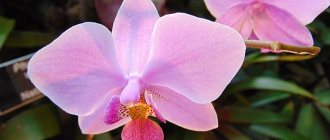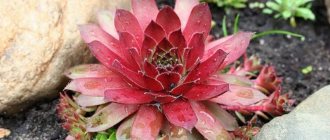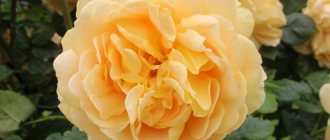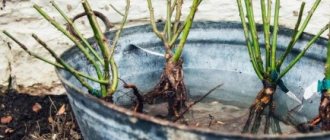The Stone Rose Orchid belongs to the Phalaenopsis genus and is a rather rare representative of it. It got its name because of the special color of the petals: white veins make them appear marbled, and the shape of the flowers makes them look like a rose.
Despite the fact that in terms of requirements it differs little from other orchids (with minor amendments), it can be found infrequently, although it has special advantages.
Diseases and pests
Orchids, like many flowers, are susceptible to a variety of diseases. Therefore, if you have to wonder why a plant loses its decorative appearance, it means that there is a possibility that the flower has contracted one of the bacterial or fungal infections. The most common among them are:
- Fusarium If a plant is frequently overwatered or planted in unsuitable soil, it may suffer from this disease. Fusarium cannot be treated, so after infection you will have to throw out the pot;
- black rot. With this disease, the orchid leaves become jet black. The affected parts must be cut off and the plant treated with fungicides. If you immediately begin to resuscitate the flower, then it can still be saved;
- Botrix. With this disease, dark spots appear on the leaves. If treatment is not started in time, the orchid petals will also suffer. Not only will they become covered with these spots, but they will also begin to crumble.
In addition to diseases, phalaenopsis can be susceptible to attack by pests. The most common among them are spider mites, thrips, scale insects, aphids and mealybugs. They suck the juices from plants, and their leaves begin to wither and turn yellow. To prevent this from happening, you first need to wash off the pests with water, and then treat the orchid with insecticides. Actelik and actara have proven themselves well in the fight against parasites.
Mealybug on flowers
Phalaenopsis is an unpretentious flower and is easy to care for. If you re-read everything written above about phalaenopsis, caring for it at home and do everything correctly, the room will drown in the colors of this unique plant.
Tags: stone, orchid, rose, phalaenopsis About the author: admin4ik
Name and origin
In the mid-18th century, a Swedish pastor sent the naturalist Lineus a flower he found on a tree on an Indonesian island. The orchid, unknown to science at that time, was incredibly beautiful, so Lineus called it that way: “Epidendrum (living on trees) lovely.”
Phalaenopsis, one of its genera, was discovered almost 70 years later in the tropics of the Malay Archipelago. The word translated from Greek means “resemblance to a butterfly” - it was large beautiful flowers that were mistaken for them at dusk.
Now, surprising with numerological coincidence, phalaenopsis numbers about 70 varieties excluding hybrids, but most of them are little known to amateur flower growers, like the exquisite variety Stone Rose.
Conditions and care
Pests of phalaenopsis orchids and their treatment with photos and descriptions of how to preserve the “royal flower” from the invasion of parasites
According to the description, the stone variety of orchid needs high-quality and regular care, otherwise the crop not only ceases to please with its appearance, but also dies
It is for this reason that it is so important to choose the right container for planting, substrate, set up an irrigation system, choose a permanent place for further growth, and much more.
Capacity
The choice of container is approached responsibly, since the root system is an integral element of photosynthesis. It is for this reason that a transparent container made of glass or plastic is perfect. Drainage is used as desired.
Accommodation in an apartment
If you plan to grow a stone variety of orchid at home, then favorable conditions must be created
The place where the culture will be located is of no small importance. Thus, it is recommended to choose a shaded place
Direct sunlight should not touch leaves or flowers. You can place the pot away from the window, but then additional artificial lighting will be required. The duration of daylight hours deserves special attention, which should not be less than 12 hours, otherwise the flowering period may not wait.
Temperature and humidity
The “Stone Rose” orchid needs high-quality care, which depends on the time of year. Thus, in the summer, the peak of beauty occurs, so in the shade the temperature should not exceed +20 degrees. If the temperature is higher, the buds will begin to fall off. In winter, when flowering has not yet begun, +15 degrees is sufficient. When the first flower stalks begin to appear, the temperature is increased by 5-6 degrees.
A high level of humidity is not required, so you should not spray the orchid daily, as this can lead to rot. The optimal humidity level is from 45 to 50%. If in winter the humidity level drops below the permissible level, then spraying the leaves is allowed.
Advice! Water should not get on the flowers.
Watering
There are several ways to water a stone orchid, the most popular are:
- The pot with the plant is immersed for some time in a container filled with water.
- Water to the very roots in the shower.
During the flowering period, it is best to water at the root, which will allow you not to disturb the flower again, and also not to change the original location, since orchids can quite easily shed their flower stalks.
Watering must be moderate
It is important to ensure that the root system is not constantly in water, as this can lead to a number of diseases. Thus, many experienced gardeners recommend letting the roots dry out a little.
If flowering has not yet occurred, the plant is immersed in water. To do this, lower the pot into another container and wait until air bubbles stop appearing
After this, it is important to completely remove excess water. For irrigation use water with a temperature of +29 degrees
It is not recommended to use liquid with high humidity levels.
Top dressing
For this variety, it is recommended to use fertilizers specifically designed for this purpose, sold in specialized stores. During flowering, fertilizing is applied several times throughout the month in small dosages. If flowering occurs in autumn or winter, then the amount of fertilizer must be reduced by 2 times. Since salt deposits may begin to accumulate in the soil, the substrate is washed monthly under running water for 20-25 minutes.
Reproduction methods
Vanilla Orchid: main types and home care options
There are many types of orchid propagation, of which there are 2 main ones.
Dividing the roots
To propagate Phalaenopsis, you need to select a suitable specimen. Its roots should be healthy, each of them should have several pseudobulbs. It can also be propagated by aerial roots. Select a formed strong root.
Reproduction by division
Flowers with a thickened stem and dormant buds are better suited for propagation. The best time for reproduction is spring. This is a time of active growth, and the plant has accumulated many useful substances. Dividing should be done after the orchid has finished blooming. First, remove the peduncle with a sharp sterile knife. Powder the cut area with charcoal.
Important! After flowering, the roots cannot be separated. The plant needs rest for 1-2 weeks.
Separation steps:
- Remove the plant from the pot.
- Clean the roots from the soil by lightly shaking the flower.
- Place the plant in water at a temperature of 30-35 degrees for 30 minutes.
- Disinfect the knife. Cut the roots.
- Sprinkle the cut area with cinnamon, activated charcoal or charcoal.
- Leave the plant to dry for 2 hours.
- Plant in pots.
Reproduction by children
It is necessary to observe the flowers and periodically moisten them with a spray bottle. The appearance of strong roots and leaves means that the orchid has taken root. You can water the plant as usual.
Reproduction by children
There are three methods of reproduction:
- Children at the roots;
- On the trunk;
- On a peduncle.
Important! Children need to be planted after the orchid has finished flowering, so that it is healthy and the peduncle is not older than 1.5 years.
The baby is on a peduncle. It looks like a kidney. They have been stimulating her since February. Plants are placed in the west or east, shading it so that the sun hits only the peduncle. During the day it is necessary to maintain 27 degrees, and at night – 17. Reduce watering. Do not feed the plant until the bud wakes up.
After this, move the plant to a dark and warm place. Normalize watering and feed the orchid on its leaves. As soon as the bud grows well, you can fertilize at the root. When the baby grows 3 leaves and the roots develop up to 2 cm (in about six months), you can separate it and plant it.
The pot is the same as for an adult plant: transparent and with holes. You can add soil from the mother orchid 1:1 to it. There must be an optimal level of temperature and humidity. Do not allow direct sunlight directed at the baby. You need to fertilize following the instructions for the propagation method.
The Phalaenopsis orchid is a plant of amazing diversity and beauty. It pleases the eye with its flowering and is easy to care for.
Home care
Truth and fiction about the blue phalaenopsis orchid: history of appearance and maintenance tips
It is not recommended to immediately replant newly acquired echeveria. She needs to be given a little time (1.5–2 weeks) of quarantine: this way you will make sure that the plant is not affected by any diseases.
It is vital to replant the succulent, since the soil in which the plant was transported is not suitable for subsequent maintenance. Young specimens are replanted annually, slightly increasing the size of the pot. But after three years, transplantation is carried out every 2-3 years.
The succulent is very light-loving and is not afraid of hot sun rays, so it is better to choose south or south-east windows for echeveria. If the plant is located on a north or north-west window, it is better to provide it with additional illumination with a phytolamp.
You need to be careful with water: stone rose does not tolerate stagnation of moisture. Water it only after the soil in the pot has completely dried.
Flowering period
The buds appear at the end of winter and bloom in spring. Flowering on average continues until late summer or early autumn, but under ideal conditions the Stone Rose can bloom all year round.
If the plant lacks something (moisture, light, nutrition, etc.), it will not bloom (or it will bloom sluggishly, for a short time). When the problem is eliminated, flowering will return to its normal rhythm.
Read about other varieties of red and burgundy phalaenopsis orchids here.
Features of flowering
Black orchid: varieties, propagation, flower care rules
An orchid can surprise you with its color
Different phalaenopsis have different duration and flowering time, for example:
- 1 month - Hieroglyphic;
- 3 months - Stuart (from January), Schiller (winter); Mini Mark Maria Teresa;
- 4-6 months - Amabilis (autumn and winter), Sandera (spring and summer),
With good care, Konskiy, Sandera, Schiller, and Stone roses can bloom constantly.
The stone rose can surprise anyone when it blooms, which is what makes it unique.
In addition, being one of the “parents” of Magic Art, it gets along well with it in the same plant and appears when the latter blooms. If you're lucky, you can buy an orchid that has flowers on one peduncle of these 2 varieties. But that’s not all: they coexist peacefully even in the same flower, dividing it in half.
The history of the orchid
The first known specimen of the Stone Rose was sent to Carl Linnaeus by a Swedish pastor in the mid-18th century.
He found an unfamiliar flower resembling an orchid on an Indonesian island and decided that a naturalist would be interested in it. Liney conducted research that showed that this is another variety of phalaenopsis, to which the name Stone Rose was assigned.
Natural types of cattleya
Natural varieties are classic tropical epiphytes, whose roots never touch the soil and absorb the substances necessary for nutrition from the air and dew. They are common in the Amazon basin and the rainforests of South America.
Cattleya bicolor
One of those species that botanists classified back in the 1830s. It grows in size by more than 50 cm, and Cattleya bicolor flowers are medium in size, about 5 cm. The lip is purple, the color of the rest of the flower is brownish, with a green or orange tone. Flowering occurs in the autumn and winter months.
Cattleya dinar
The variety is distinguished by the delicate appearance of its flowers and rich aroma: against the background of a bright purple lip and yellowish neck, graceful petals of a light pinkish hue bloom. This spectacle can be seen in spring or autumn.
Cattleya maxima
Cattleya Maxima has a number of subspecies. They are united by the warm shades of the petals. The ground color may be whitish or purple, and the core color may be yellow. Each peduncle can produce a dozen flowers, emitting a light but pleasant scent.
Cattleya mix
Cattleya mix has bright pink petals. The height of the variety reaches 50 cm. Its flowering occurs in autumn. The plant is moisture- and heat-loving.
Cattleya schroederae
A characteristic feature of Schroeder's Cattleya is its variety of colors, from white to purple with an orange or golden throat. The duration of bud dissolution is about a month. At least 7 inflorescences can open simultaneously on one plant.
Cattleya bowringiana
Cattleya Bowring is a large variety with a pseudobulb up to 75 cm long, several narrow oblong leaves and tall peduncles. The diameter of the flowers is average, up to 7 cm, and the color is elegant - lavender or purple. During the flowering period, from autumn to winter, up to 25 buds are formed on some specimens.
Cattleya mossiae, or Easter
The variety got its name because of the flowering time, which usually coincides with Easter. The orchid is large-flowered, with petals painted in pale pink, whitish or lilac shades, a yellowish core, and a fringed border along the edge of the lip.
Cattleya trianae
A large variety of cattleya orchid up to 50 cm in height and flower sizes up to 20 cm. Their color is light pink, beautifully combined with the rich crimson shade of the lips. Flowering occurs in winter and lasts until the end of spring.
Cattleya aclandiae
Cattleya Eklanda is a dwarf orchid that grows only 8–10 cm. It has several green elliptical leaves. A characteristic feature of the Cattleya orchid is red or almost black spots on the leaves, the number of which increases when exposed to direct sunlight. The petals are also covered with spots of dark red, purple shades. Peak flowering occurs at the end of spring.
Cattleya forbesii
A mini-orchid whose height rarely reaches 20 cm. Large flowers of beautiful greenish shades with a white lip bloom on a small plant. Cattleya Forbes was discovered and described by botanists in the middle of the 19th century.
Cattleya labiata, or big-lipped
A large-flowered orchid with lilac or pinkish petals and a deep purple lip. It has single-leaved wrinkled spindle-shaped pseudobulbs 20–30 cm long. It blooms in July-August.
Cattleya warscewiczii, or giant
Another variety of cattleya with large flowers and pseudobulbs. The size of the first reaches 25 cm. The lip is dark purple with several yellowish spots in the center. It does not bloom for long, up to 2 weeks. This period begins in May.
Main varieties of Phalaenopsis
There are quite a lot of flower varieties: Liodoro, Big Linden, Mandala, Stone Rose and others.
What does an orchid look like?
Phalaenopsis Liodoro
The Liodoro hybrid was bred by scientists; its distinctive features are the presence of a smell and an unusual color. Its second name is Sweetmemory. The variety was registered in America in the 80s. He was brought out by R. Smith. The scientist crossed the varieties Deventeriana and Violacea. The plant turned out to have shiny leaves, large flowers and tall peduncles.
Phalaenopsis Big Linden
The flower stands out for its resemblance to the wings of a butterfly. Big lip is translated as “big lips”. The flower in the middle has a lower petal that is quite large and also slightly unfolded. The petals themselves are easily injured, soft, tender, so the plant is difficult to transport.
Phalaenopsis Mandala
The Mandala Orchid has a very amazing color. Its flower is creamy-golden, the center is white, the lip is small, the color of a tiger. The length of the plant is 60 cm. The size of the flower can reach 9 centimeters. Like other species, Mandala needs high humidity, moderate watering and protection from the scorching rays of the sun.
Important! Between flowering there are 2-3 months of dormancy.
Phalaenopsis Stone Rose
This variety of Phalaenopsis is called Echeveria. Also his other formulations are Stone Rose, Green Rose, Stone Flower. Belongs to perennial herbaceous plants of the Tolstyankov family. Originally grown in Mexico, can also be found in Central and South America.
There are more than 200 varieties in nature. The plant is popularly called “stone rose”. In appearance it looks like a rose flower. It has no thorns, the leaves are smooth, as if carved from stone.
The plant either does not have a stem or it is very short. The leaves are arranged in a spiral, fleshy, covered with fluff. They differ in oval or flat shape.
Phalaenopsis Stone Rose
The flowers are bright fiery red or orange. They look like a bell in appearance.
Other Phalaenopsis species
There are many other varieties:
- Hybrid Dendrobium Berry Oda, characterized by its tolerance to high temperatures and compactness (height - up to 40 cm).
- The white Amabilis orchid is the progenitor of many varieties. The most popular hybrids are Diamond, Gold Lip, Salt Lake and others. They differ in flower size and height.
- The blue orchid is a rare and expensive hybrid. In 2013, Japanese breeders developed the Aphrodite variety, to which they added the blue Commelina gene. The world's first blue orchid was called Aphroditeblue. The remaining types are artificially colored through watering.
- Phalaenopsis Wildcat is a rare spotted species native to Australia and the Philippines. There are more than 20 varieties of the flower. The color of the bud is white-yellow with violet-purple spots. The structure of the petals is dense, waxy and sparkling. Depending on care, specks may be larger or smaller.
- Phalaenopsis mini - is distinguished by medium-sized flowers, 4 cm in diameter, short peduncles and leaves up to 15 cm long. The micro orchid pleases with long flowering. The care requirements are the same as for large individuals.
Phalaenopsis mini - Phalaenopsis Cleopatra is the most popular orchid in terms of sales in the world. It is distinguished by its unpretentiousness and good survival in low humidity. The flowers are a mix of white or white-yellow buds with lilac, pinkish, and purple specks. There are species with pink flowers.
Description of the plant
One of the favorite plants of landscape designers is Sempervivum (Latin: “always alive”), or Stone Rose. With its help, they create amazing needle-shaped fields in gardens, collect incredible compositions in flower beds and add color to the greenery.
In our area, Molodilo is often called “Stone Rose”. Looking at the plant for the first time, the association with this particular flower immediately comes to mind. And he was nicknamed the stone one for his unpretentiousness, endurance and good adaptation.
Juvenile is a succulent with flat, dense or pointed leaves that form a rosette. The rosette is located directly on the ground, without a pronounced stem, which is why the stone rose is used as a ground cover plant.
The color of a stone rose varies. In sunny areas it is brighter and has different colors, and in the shade it is green with a small red border along the edge of the leaves.
Stone rose is distinguished by its frost resistance and method of propagation. The plant produces “whiskers” on which children are formed. Loves sun, little watering and fresh air. But with all the love for natural conditions, the youngsters perfectly adapted to domestic conditions.
Transfer
The Stone Rose requires it in the following cases:
- the container is small: the plant rises above it and the roots crawl out into the drainage holes;
- replacement of the substrate (every 2-3 years);
- dividing the plant;
- treatment.
It is optimal to replant a flower in a dormant state. In this case, the tool and cuts are processed in the same way as when trimming a peduncle. If the substrate needs to be replaced, it is prepared in advance. Water will simply flow down dry bark, so it is placed in water for a day or two for impregnation. After this, the bark is washed and then used for substrate.
All cuts must be processed
The transplant happens like this:
- The orchid is removed from the old pot. The roots that interfere with this, which have crawled out into the drainage holes, are trimmed;
- When replacing the substrate, the roots are freed from the old one. If it does not separate well, the roots are washed in a basin with warm water and dried for 1-2 hours;
- the roots and flower are examined. Everything rotten and dried is cut off, pests are destroyed, and the cuttings are processed;
- The orchid is placed in the middle of the pot, at the bottom of which there must be drainage (expanded clay, polystyrene foam) and a layer of medium-fraction bark. Then its roots are covered with a substrate made from a mixture of fine bark and moss - it will allow the roots to be covered without voids that will interfere with flowering;
- After transplanting into a dry substrate, the flower needs to be watered. Transplanting into moist soil does not require watering.
Pruning
The drying peduncle should not be touched: it releases accumulated nutrients to the plant. If it is completely dried out, be sure to cut it 2 cm above the rosette. Green - can please with buds or children, but if it stands without development for six months, it is pruned 1 cm above the last dormant bud (meristem).
The cut area is treated with cinnamon, crushed activated carbon or regular brilliant green. The operation is performed with a disinfected pruner or blade.
If the stem of the flower stalk is hollow, the accumulation of water there can lead to rotting. This cut is sealed with wax.
In spring, pruning can be done to encourage flowering. In this case, the peduncle is cut 2-2.5 cm above the meristem. Often this is the 2nd or 3rd bud: the closer to the base of the rosette the side shoot grows, the more abundant the flowering will be.
What do you need to know before buying a plant for your home?
You have decided that you want to grow rock roses at home. How to prepare for a meeting with a plant?
A small checklist below.
Read about the Stone Rose. Find out what conditions she needs, what is ready in the house, and what you will have to buy in addition to create them.
What you will need to replant and care for it.
In the store, be sure to pay attention to where the plant stood. Was there backlighting? Stone rose loves sunny color, in the shade it loses turgor and changes color
Are there doors or windows nearby? Are there any drafts? Ideally, the plant is located in conditions close to natural.
Look closely at younger plants. They tolerate stressful situations better and adapt to new conditions more easily.
Check the soil. If it's wet, ask your dealer when it was last watered. If it is very damp and there is a lot of water in the pan, the plant is flooded, there may be problems with the roots.
Inspect the flower for parasites. Is there a coating on the leaves? Damage to the stem? If you decide to buy such a plant, be prepared to rehabilitate it. If the plant is blooming, choose one that has fewer buds but more open flowers.
Don't forget about packaging, and in winter you also need to protect from the cold.
Stone rose: how to grow an unusual flower at home
In this article, Kvartblog deals with the questions of how to care for the “Stone Rose” flower at home, what signs and superstitions exist regarding this plant, and how to combine stone roses in compositions.
Description of the plant
One of the favorite plants of landscape designers is Sempervivum (Latin: “always alive”), or Stone Rose. With its help, they create amazing needle-shaped fields in gardens, collect incredible compositions in flower beds and add color to the greenery.
In our area, Molodilo is often called “Stone Rose”. Looking at the plant for the first time, the association with this particular flower immediately comes to mind. And he was nicknamed the stone one for his unpretentiousness, endurance and good adaptation.
Juvenile is a succulent with flat, dense or pointed leaves that form a rosette. The rosette is located directly on the ground, without a pronounced stem, which is why the stone rose is used as a ground cover plant.
The color of a stone rose varies. In sunny areas it is brighter and has different colors, and in the shade it is green with a small red border along the edge of the leaves.
Stone rose is distinguished by its frost resistance and method of propagation. The plant produces “whiskers” on which children are formed. Loves sun, little watering and fresh air. But with all the love for natural conditions, the youngsters perfectly adapted to domestic conditions.
Types of Molodilo (Stone rose)
Stone rose comes from the Crassulaceae family and has approximately 30-60 species. Such a wide range of botany is explained by the fact that the taxonomy of the plant genus has not yet been established. The most common juveniles for the home:
1. Roofing is the most popular plant in Russia; it easily hybridizes with other species, due to which there are already a huge number of its varieties in the world, some of which don’t even have names.
This stone rose can be found in the south and center of Europe, in the European part of Russia and in Asia Minor. A perennial plant growing up to 20 cm in diameter and up to 8 cm in height.
Produces peduncles up to 60 cm, blooms in July-August with light and dark purple flowers.
2. Cobweb - grows in the mountains of Western Europe. Perennial succulent that reproduces once in a lifetime. The rosettes are small, up to 2 cm in diameter, located close to each other. The leaves are green or reddish with a red tip, on which there are many white hairs. They cover the rosettes with a thick cobwebby cover.
3. Mountain - in nature can be found in the alpine belt of the mountains of Europe. A perennial with sharp dark green leaves, which are pubescent with glandular hairs on both sides. The diameter of the rosette is no more than 2 cm, and the height of the peduncles reaches a maximum of 5-8. The inflorescence is corymbose, with soft purple-violet petals.
4. Caucasian - can be seen in the wild only in the Caucasus. A tall (for succulents) perennial plant sometimes reaches 25 cm. The rosettes are small, maximum 5 cm. It has oblong, smooth (rarely with slight pubescence) leaves. It blooms with branched 10-15 flowers with violet or lilac-purple petals.
5. Dwarf - grows at 2000-3000 altitude of the Caucasus Mountains. A miniature plant up to 2.5 cm in diameter with green, oblong, pointed leaves, the edges of which have small hairs. The inflorescences are small, lilac-purple, with a dark stripe in the middle, reaching a maximum of 8 flowers.
6. Mramornoe - originally from central Europe, known since the 18th century. Flat rosettes grow up to 10 cm. There is slight pubescence at the beginning of the plant’s life; in adulthood, the leaves are already smooth, green or red in color with colored veins.
7. Russian - a once-in-a-lifetime blooming perennial, reaching 35 cm. Its stems are furrowed and slightly fluffy. The leaves are wedge-shaped, slightly widened and also fluffy. It blooms in late summer with multi-flowered branches and loose yellow flowers.
8. Hybrid - under this name quite a few varieties and forms of plants are combined. In stores you can most often find them without a name and in a large assortment. The most popular option is a green leaf with a red tip, which can later change color.
https://www.youtube.com/watch?v=XicGUd7LpnM
Among flower growers, the stone rose has gained popularity both for its beauty and ease of care. Some joke: the worse the care, the better. The plant prefers poor rocky and sandy soils. It easily mixes with other species and pleases lovers with new varieties every year.
Signs and superstitions
There are quite a few prejudices about the stone rose. But believe in them or not, decide for yourself. Some believe that the flower has negative energy, because it can often be found in cemeteries. And this choice is understandable, the young do not require special care, can grow on stones, are frost-resistant and look attractive.
In the Middle Ages, on the contrary, people believed that a stone rose drove away evil from the house and its owner. And King Charlemagne forced young fish to be bred on roofs to “scare off” lightning.
In Rus', girls rubbed the flower on their cheeks for a bright blush. And the tincture of young people was considered medicinal; it was used in the treatment of eyes and ears.
Another sign comes from the times of the Crusade. The French pharmacist Odo wrote about the custom of carrying young milk with you, so you could protect yourself from a scorpion sting.
What do you need to know before buying a plant for your home?
You have decided that you want to grow rock roses at home. How to prepare for a meeting with a plant?
A small checklist below.
- Read about Stone Rose . Find out what conditions she needs, what is ready in the house, and what you will have to buy in addition to create them. What you will need to replant and care for it.
- In the store, be sure to pay attention to where the plant stood . Was there backlighting? Stone rose loves sunny color, in the shade it loses turgor and changes color. Are there doors or windows nearby? Are there any drafts? Ideally, the plant is located in conditions close to natural.
- Take a closer look at younger plants . They tolerate stressful situations better and adapt to new conditions more easily.
- Check the soil . If it's wet, ask your dealer when it was last watered. If it is very damp and there is a lot of water in the pan, the plant is flooded, there may be problems with the roots.
- Inspect the flower for parasites . Is there a coating on the leaves? Damage to the stem? If you decide to buy such a plant, be prepared to rehabilitate it.
- If the plant is blooming, choose where there are fewer buds , but more open flowers.
- Don't forget about packaging , and in winter you also need to protect from the cold.
Transfer
After purchase, you need to let Molodilo stand for 10-14 days separately from other plants, to get used to the new room and its conditions. And then start transplanting.
We prepare the necessary:
- wide pot - remember that the stone rose reproduces with “tendrils” along the edges, so choose a container larger than the diameter of the rosette;
- drainage - expanded clay or small stones;
- soil - you can buy ready-made for succulents or make your own. Stone rose loves loose, rocky, sandy soil. Each gardener has his own “recipe” for soil, some plant simply in rock soil;
- plant - we tear off the dried leaves from below, empty and rotten roots, if any.
Next, we proceed directly to transplanting the plant :
- place drainage on the bottom of the pot (about ⅓ of the container);
- pour soil, make a small hole with your fingers;
- we plant our Young and sprinkle soil around the edges;
- It’s better to refrain from watering; you’ll do it in a few days.
Home care
Stone rose loves bright, diffused light. In the shade, the plant stretches and loses its shape. Succulent lovers solve this problem by adding additional lighting. You can buy a special phytolamp, or you can illuminate it with regular ones, pointing them at the plant.
Moisture accumulates in the leaves of Juvenile and provides nutrients for a long time. Therefore, watering should be limited, as well as frequent feeding. It’s not for nothing that the flower is called stone. In summer, it is enough to water the plant once every 2 weeks, and in winter - once every 20-30 days.
Replanting every year is not required, only if the plant becomes too small for space.
Reproduction
New Rejuvenating plants can be obtained in two ways:
1. Seeds are a labor-intensive process that does not always end in success. In spring, the seeds are laid out on slightly moistened soil, sprinkled on top and covered with film. Place in a place with a temperature of 20 degrees. After 15 days, the first shoots begin to appear. Sometimes a little longer. Then it remains to monitor the process, periodically ventilating the container in which the flowers grow.
2. By shoots - when “antennae” appear and small rosettes have formed, you need to carefully separate them from the mother plant and transplant them into a separate, small container. How to properly transplant Molodilo, we wrote a little higher.
What to combine stone rose with in compositions?
At home, stone roses are also used to decorate the interior. Various compositions look like original and unique decor. combine Molodilo with other plants , natural materials or various accessories .
You can choose a companion plant based on similar preferences. The best option would be other succulents: similar echeveria, rowley's ragwort, aloe and many others.
You can create compositions with orchids or small trees such as Myrtle or Myrsina.
Of natural materials, stone seems to be the most advantageous option. But wood, glass or, for example, nut shells also decorate Molodilo well.
As for accessories, they can be matched to the colors of the interior, textiles, plants, or any others you like. For inspiration, check out our small selection.
Quartblog Digest
Succulents: types of cute fat ones and caring for them - The most complete instructions for caring for succulents at home. We will show examples of plants in the interior.
How to grow Vanilla Frize hydrangea if you don’t know anything about it - Kvartblog tells how to grow Vanilla Frize hydrangea, what is required for care, and shows photo examples of how beautifully this plant blooms.
Know and be able to: how to grow orchids - We will tell you how to grow and care for several types of indoor orchids at home, which are often sold in stores.
Hanging flower pots: DIY and more - Eight tutorials to help you make the perfect hanging flower pot, and eight links to ready-made items.
Artificial flowers in the interior - The skillful art of imitation. Artificial flowers in the interior - beautiful examples, useful tips and important recommendations from Kvartblog!
Source: https://kvartblog.ru/blog/kamennaja-roza-kak-vyrastit-neobychnyj-tsvetok-u-sebja-doma/
Transfer
We invite you to read: Description and characteristics of tomato variety Wild Rose
Note! The flower needs to change the substrate and pot size every 3 years. In order for the orchid to successfully grow and develop further, you must follow the step-by-step instructions for replanting:
In order for the orchid to successfully grow and develop further, you must follow the step-by-step instructions for replanting:
- First, the orchid needs to be removed from the pot. If you can’t pull out the flower, you can crush the pot or even cut it.
- The roots need to be freed from the old bark; if any piece has grown to the flower, then it’s not a big deal.
- It is imperative to remove rotten or dead roots, but it is better not to touch the healthy part.
- Before planting, the flower must be dried. This process takes on average 2 hours.
- Phalaenopsis is planted in the soil and not watered for 5 days. Also, it is not recommended to apply fertilizing during the first month.
Transfer
Description of the variety
In the wild, Phalaenopsis orchids live in humid, warm forests. They originated in Asia and number about 70 species. According to the description, the structure of orchids consists of tuberidia or pseudobulbs, but Phalaenopsis lacks all of this.
This is a monopodial orchid that grows slowly in height. Orchids are propagated using bulbs. How many years an orchid lives depends on the amount of vital energy of a flower, but it decreases when flowering and development of children are stimulated. During the breeding season of Phalaenopsis, fertilizers and fertilizing must be used.
Description of leaves and tree
Phalaenopsis is an orchid with a special rhythm of development, growth and smell. To determine the age of a plant, count the number of large leaves.
An adult tree has the shape of a rosette with two rows of leaves arranged.
The house Phalaenopsis orchid has a short stem that grows upward. And the aerial root system is well developed. Their thickness is up to 7 mm in diameter. The roots are covered with a layer of special absorbent tissue - velamen. They have a silvery-green color.
Phalaenopsis at home reaches 50-70 cm. In a healthy plant, the rosette consists of 4-6 leaves. Up to 2 new leaves appear during the year. They are dense and colored a rich dark green. They have an oblong-oval shape. They are located alternately, and a peduncle grows between them.
Description of colors
Peduncles, depending on the type, are long (up to 80 cm) and short (about 20 cm). They have curved or straight shapes. Flowers also have different diameters from 2 to 15 cm. They are collected in racemose inflorescences and resemble the shape of a butterfly or star. The growth period varies from 2 months to six months.
The Phalaenopsis orchid has a pleasant and unobtrusive aroma.
The house Phalaenopsis orchid blooms twice a year - in spring and autumn. The flowering period depends on the interaction of the general condition of the plant and the characteristics of its care.
Types of varieties
The phalaenopsis flower is distinguished by the size of the leaves, the length of the peduncle and the color. Characteristics of varieties:
| Variety name | Description |
| Amabilis | Leaves are from 30 to 50 cm, green, up to 12 cm in diameter. The petals are white and the flower lip is yellow or peach. Amabilis bloom from early autumn to March. |
| Schilleriana | Flowers come in purple or single color. Blooms in winter. |
| Stuart (Stuartiana) | Peduncles are long - 80 cm in length. The petals are purebred with red spots at the base. They bloom from mid-winter to March. |
| Amsterdam Jordan | Raspberry petals in a dark dot. The lip has a burgundy tint. |
| Horse (Equestris) | Pleasant aroma and large leaves up to 13 cm. Flowers purple or lilac. |
| Natasha (Natasha Aiko) | It has 3 pairs of leaves and reaches 12 cm in height. Pink or green with spots all over the flower. |
Variegated Phalaenopsis variegated includes varieties: Filipinensis and Lindeni. The species Stone Rose, Little Zebra, Sumatra, Ping, Rossini and Sacramento are famous for their crimson shades, and the small-flowered variety Phoenix, Venus, Violet, Tonka and Pulhra are famous for their rich scent.
The Phalaenopsis orchid has many varieties.
Yellow petals: Solid Gold, Nina Queen, Yara, Mango and Maya with red splashes. The ampelous saffron milk cap is colored orange, like Surfsong and Novelty.
Varieties with white petals:
- Leopard Prince;
- York;
- Pinglong;
- Ikaria;
- Leonardo;
- Cambridge;
- Phalaenopsis super Beautyful.
- Tetraspis and Gemeng - white petals with red dots.
Purple color is characteristic of the varieties Phantom and Extra, Multi, Martin, Angel, Nyezhdnik, Cherry and Jewel. The Manna species has green leaves with purple dots.
The Mandala variety has creamy caramel petals with a Leopard lip. Sesame is distinguished by a tiger pink and white pattern on its petals. Interesting flowering species: Panda, Elegant, Deborah, Aloha, Leo, Ravello, Zion and Tabor.
Phalaenopsis - varieties (key)
The Phalaenopsis orchid has a wide variety of varieties. There are so many of them that there is not a single catalog that would include all the colors that exist today.
We present to your attention a guide to phalaenopsis varieties with photos. We hope you will find your favorite here too.
Phalaenopsis orchids, varieties starting with the letter “A”
| Anthura marbella flower 8 cm | Aphrodita flower 6 cm |
| Antwerpen flower 7 cm | Aranca flower 7 cm |
| Apple Blossom flower 8 cm | Astral flower 7 cm |
| Atlantis flower 7cm | Alice Girl flower 5 cm |
| Amadeus flower 7 cm | Almeria flower 8 cm |
| Amalfi flower 8 cm | Amore mio stripe flower 3 cm |
| Amolar flower 6 cm | Ancona flower 7 cm |
| Angel Face flower 9 cm | Anna White flower 10 cm |
| Anthura Carmelo flower 4 cm | Annapolis flower 8 cm |
| Anthura Darwin flower 8 cm | Anthura Gold flower 5 cm |
| Alaska flower 7 cm | Autumn Wind flower 8 cm |
| Aberdrot flower 9 cm | Alfonco Moreno flower 8 cm |
| Autumn Sun flower 5 cm | Autumn Sun 'Hawaii' flower 5 cm |
| Arakaki White World Dream 'Kitty' | Anna Larati Soekardi |
| Arakaki 'Spring Fairy' flower 8 cm | Arakaki Spring Fairy 'Arakaki 1′ |
| Anastasia flower 8 cm | Alexandra flower 7 cm |
| Adelaide | Alabaster |
Part 2
Part 2
Phalaenopsis varieties by color - YELLOW
Phalaenopsis orchids, varieties starting with the letter
"A" "B" "C" "D" "E" "F" "G" "H" "I" "J" "K" "L" "M" "N" "O" "P" "Q » "R" "S" "T" "U" "V" "W"
"X" "Y" "Z"
Related posts:
Category: Orchids | Tags: varieties, phalaenopsis | Permanent link
Transfer
Note! The flower needs to change the substrate and pot size every 3 years. In order for the orchid to successfully grow and develop further, you must follow the step-by-step instructions for replanting:
In order for the orchid to successfully grow and develop further, you must follow the step-by-step instructions for replanting:
- First, the orchid needs to be removed from the pot. If you can’t pull out the flower, you can crush the pot or even cut it.
- The roots need to be freed from the old bark; if any piece has grown to the flower, then it’s not a big deal.
- It is imperative to remove rotten or dead roots, but it is better not to touch the healthy part.
- Before planting, the flower must be dried. This process takes on average 2 hours.
- Phalaenopsis is planted in the soil and not watered for 5 days. Also, it is not recommended to apply fertilizing during the first month.
Transfer
Phalaenopsis fringed
Growth:
East and Central Java, Sarawak and Sumatra. Phalaenopsis fringe is found on Mount Kinabalu and mountain passes at an altitude of 792–1311 m above sea level. It usually grows in fairly well-lit places, on trees under the sun penetrating the foliage or in moss on the southern or eastern slopes of limestone cliffs, where the plants are illuminated by bright reflected light.
Climate in natural habitats:
- Recorded temperature range from +15.0°C to +31.7°C.
- Average humidity is 75–80%.
- Precipitation from 13 mm. in March up to 602 mm. in July.
- Average temperatures (day/night) throughout the year are +26–27°C/+19–20°C.
Description of the plant:
Plant size and type:
Phalaenopsis fringe is a small to medium-sized monopodial epiphyte or lithophyte up to 15–23 cm high.
Pseudobulbs:
None.
Leaves:
Each plant has from three to five leaves 15–23 cm long. The leaves are elliptical, curved, with wavy edges.
Peduncle:
During the year, fringed phalaenopsis usually produces two curved or curved peduncles 25 cm long. Flowers are rarely located in the inflorescence.
Flowers:
Numerous flowers with a diameter of 2.5–3.8 cm bloom simultaneously. The pointed, fleshy petals and sepals can be white or pale apple green with dark red spots. The lip is white with yellow and red-purple spots and strongly fringed edges.
Flowering period: from March to May.
Agricultural technology:
Temperature:
The average daytime temperature throughout the year is +26–27°C, the average night temperature is +19–20°C, which gives a daily difference of 6°C. These are the maximum values that are observed under natural conditions; in care, the temperature should be slightly lower. Phalaenopsis fringe does not tolerate very high temperatures during the summer heat.
Lighting:
12,000–14,000 lux, which is higher than most other Phalaenopsis. This species can grow on a windowsill, in the sun shining through the foliage of trees outside the window, provided that the daytime temperature does not exceed +27°C and there is good air circulation.
Watering:
Phalaenopsis fringe needs to be watered abundantly, but the substrate should dry quickly after watering. For irrigation, you need to use warm water with a temperature of +18°C. The dry period in the natural habitat of this orchid lasts 2–3 months.
Fertilizer:
During the growing season, you need to feed the plant with 1/4–1/2 dose of orchid fertilizer once every one or two weeks.
Substrate:
To reproduce the conditions in the natural habitat of this plant, you can use a substrate consisting of pieces of volcanic rock with a diameter of 13 mm, which dries quickly after abundant watering. Replanting is best done immediately after flowering or at any other time when new roots are actively growing.
Air humidity:
75–80% throughout the year. Constant ventilation is very important for this orchid.
Rest period:
In winter, the average daytime temperature is +26–27°C, the average night temperature is +19–20°C, and the daily difference is 7–8°C. It is necessary, if possible, to strictly observe the temperature regime. The illumination level can be increased to 15,000 lux for about two months. Humidity should be reduced to almost 65%, and watering should be limited to rare sprays. Feeding should be stopped. Editorial team LePlants.ru
Conditions and care
For an orchid, comfortable conditions will be:
- humidity from 30 to 40%;
- ventilation and air circulation;
- temperature - 15-25˚C;
- diffused light or partial shade.
Stone rose is capricious, like any beauty. If you don’t like the new house, it won’t bloom or even live there, despite the most wonderful conditions. Conversely, it will briefly withstand both higher (up to 42˚C) and lower (up to 12˚C) temperatures and other maintenance flaws, if everything is happy.
Caring for it consists of providing the necessary conditions.
Capacity
Select a transparent container: the roots need access to light to participate in photosynthesis. In size it should exceed the root part by 2-3 cm.
In addition, the roots need air circulation, so it is necessary to have drainage holes in the bottom and sides of the flowerpot.
Accommodation in an apartment
It is better to place the flower on a western, eastern or north-eastern window with bright but diffused light. If the side is south, the plant is placed on a table under the window, protected from direct sunlight.
Temperature and humidity
The desired temperature is maintained by ventilating or heating the room. To increase humidity, the flowerpot is placed on a tray with wet pebbles, and the frequency of watering is adjusted.
Watering
Here you need to remember the following rules:
- The soil must be dry before watering. This will be indicated by a lack of moisture on the walls of the flowerpot and lightened roots, usually green.
- Only the substrate is watered. This can be done not only from above, but also from below: the flowerpot is lowered into water for 20-30 minutes to soak the substrate through the drainage holes).
- Water for irrigation is taken clean, soft and settled.
Top dressing
Fertilizers improve flowering
Phalaenopsis not only needs to be watered, but also periodically fed with fertilizers. For example, universal mineral complexes:
| Term | Name of fertilizer | Proportions | Submission rules | Way |
| 2 times/month | Kemira Lux | 1g/l water | on a wet substrate | watering from above |
With this feeding, the substrate is washed weekly with running water so that there is no excess of mineral salts.
A month after transplantation, it is recommended to feed the plant with mineral mixtures with potassium, magnesium and nitrogen. The frequency and dosage are always indicated on the packaging. Epin and Zircon are used to relieve transplant stress.
An orchid, grateful for good care, can produce 5 flower stalks per year and bloom almost constantly.
Distinctive characteristics of the variety
Phalaenopsis Chiada Stacy is a rare variety and is distinguished by its unusual flowers, the petals of which appear to be marbled, and by its particularly long flowering period.
The stone rose has one vertical stem, which reaches a height of about 80 cm, and can grow up to 1 m. The peduncle is branched, differs little in height from the plant itself, but can stretch a little higher. The leaves are collected in a rosette, wide, up to 30 cm in length.
The roots are dense and tangled, participate in photosynthesis, and therefore need access to light. They grow downward, not sideways, so the pot may not be wide, but it must be deep.
Green with a salad tint
Green beauty orchids are becoming more and more numerous. This is how the world works: everything that nature did not create, man tries to create.
Dendrobium Anna Green. Propagated by children and division of the peduncle. Care is standard for the main types of orchids. It is not recommended to soak the roots for a long time. Water as the soil dries out. This is very harmful for dendrobium. This hybrid can grow in an opaque pot.
The petals are yellow-green and have a bright dark crimson lip. The flowers are not large.
Phalaenopsis Bellina. Native to Borneo and Malaysia. Epiphyte. The flowers are fragrant, whitish-green with a yellow tint.
Pests and their control
It is convenient to present the main pests of the Stone Rose and measures to combat them in the form of a table.
| Pest | Damage | Control measures |
| mealybug | leaves turn yellow and fall off | treatment with a solution of laundry soap |
| spider mite, initial stage | silver web on leaves | Also |
| spider mite, advanced stage | silver web on leaves | acaricide treatment |
| thrips | brown spots on flowers and leaves | fitoverm |
| scale insect | tubercles on leaves | 2-time treatment with soap solution at weekly intervals |











